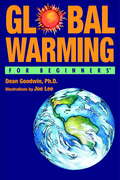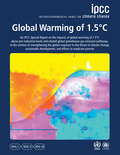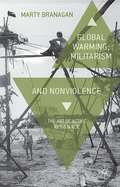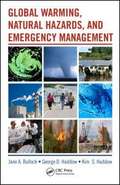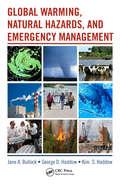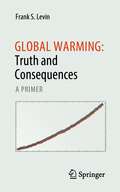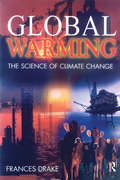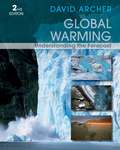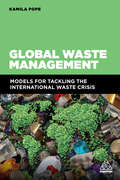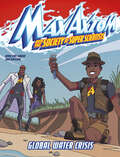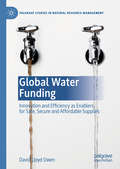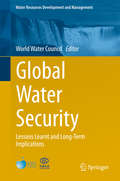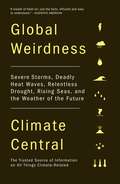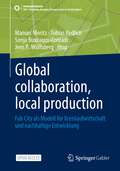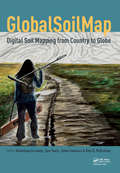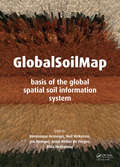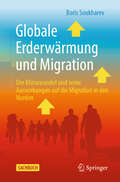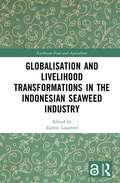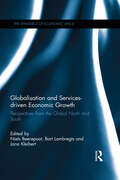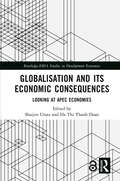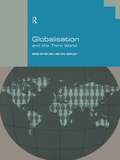- Table View
- List View
Global Warming for Beginners
by Dean GoodwinThe science is in: Global warming is for real. But what does it all really mean, and what can or should we do about it? This clear, fluid narrative by a leading scientist and educator takes a scrupulously balanced approach in explaining for the reader the history of global climate monitoring and change, and the who’s, how’s, what’s, when’s, where’s and why’s of the interaction between human activity and recent trends in the Earth’s climate. Global Warming For Beginners is organized into five compelling sections: Global Warming, An Introduction The Cause The Consequences The Solutions What Steps Can I Take? Working from the premise that no one can do everything but everyone can do something, Goodwin challenges readers with experiments they can conduct to gain a better understanding of the science underlying the problems facing our planet, and concludes with a list of fifty easy actions people can choose from to start doing their part in the effort to slow or stop global warming. As with all For Beginners titles, this volume is illustrated throughout with entertaining drawings that help readers understand and retain the information in Goodwin’s lively and comprehensive text.
Global Warming of 1.5°C: IPCC Special Report on impacts of global warming of 1.5°C above pre-industrial levels in context of strengthening response to climate change, sustainable development, and efforts to eradicate poverty
by IPCCThe Intergovernmental Panel on Climate Change (IPCC) is the leading international body for assessing the science related to climate change. It provides regular assessments of the scientific basis of climate change, its impacts and future risks, and options for adaptation and mitigation. This IPCC Special Report is a comprehensive assessment of our understanding of global warming of 1.5°C, future climate change, potential impacts and associated risks, emission pathways, and system transitions consistent with 1.5°C global warming, and strengthening the global response to climate change in the context of sustainable development and efforts to eradicate poverty. It serves policymakers, decision makers, stakeholders and all interested parties with unbiased, up-to-date, policy-relevant information. This title is also available as Open Access on Cambridge Core.
Global Warming, Militarism and Nonviolence
by Marty BranaganMilitarism is the elephant in the room of global warming. Of all government sectors, 'Defence' has the highest carbon footprint and expenditure, yet has largely been exempt from international scrutiny and regulation. Marty Branagan uses Australian and international case studies to show that nonviolence is a viable alternative to militarism for national defence and regime change. 'Active resistance', initiated in Australian environmental blockades and now adopted globally, makes the song 'We Shall Not Be Moved' much more realistic, as activists erect tripod villages, bury, chain and cement themselves into the ground, and 'lock-on' to machinery and gates. Active resistance, 'artistic activism', and use of new information and communication technologies in movements such as the Arab Spring and 'Occupy' demonstrate that nonviolence is an effective, evolving praxis.
Global Warming, Natural Hazards, And Emergency Management
by George Haddow Jane A. Bullock Kim HaddowScientists predict the earth is facing 40-to-60 years of climate change, even if emissions of carbon dioxide and other global warming gases stopped today. One inevitable consequence of the greenhouse gases already in the atmosphere will be an increase in the frequency and severity of natural disaster events. Global Warming, Natural Hazards, and Emergency Management documents the imperative need for communities to prepare for the coming effects of climate change and provides a series of in-depth, road-tested recommendations on how to reduce risks for communities and businesses. Frontline Advice for Increasing Defenses and Reducing Impacts of Global Warming Authored and edited by emergency management and environmental protection professionals from the Federal Emergency Management Agency (FEMA) and the Sierra Club, this book offers case histories from communities across America that have successfully reduced the extent and consequences of natural disasters. These examples are becoming increasingly important to understand and replicate as the risks to communities created by a changing climate rise. This book recognizes three fundamental principles essential to developing a disaster-prevention strategy: The protection of natural systems is an important security measure The reduction of disaster risk, not just response, is of great importance Local communities must take the lead in prevention efforts Provides Local Governments with Replicable Case Histories of Hazard Mitigation Efforts This no-nonsense reference is a procedural roadmap for emergency managers, policy makers, and community officials. It explains how to develop community partnerships among a myriad of stakeholders; identifies staffing and resource requirements for successful programs; and provides a step-by-step demonstration of the disaster-planning process at the community level.
Global Warming, Natural Hazards, and Emergency Management
by Jane A. Bullock George D. Haddow Kim S. HaddowScientists predict the earth is facing 40-to-60 years of climate change, even if emissions of carbon dioxide and other global warming gases stopped today. One inevitable consequence of the greenhouse gases already in the atmosphere will be an increase in the frequency and severity of natural disaster events. Global Warming, Natural Hazards, and Eme
Global Warming: A Beginner's Guide to Our Changing Climate
by John Gribbin Fred PearceBig ideas made simple -- six books in an incredible new series that explains important scientific ideas more clearly than ever before. Climate change resulting from an increase in greenhouse gases is perhaps the greatest threat to our planet's future. Here, Fred Pearce examines the causes and dramatic effects, and what can be done to remedy the situation -- before it's too late. This stimulating new series uses an innovative mix of graphics, artwork, and photographs to explain and illuminate the most important scientific topics of the day. Unique in popular science guides, Essential Science uses bright, full-color images to make traditionally "difficult" subjects more accessible. Each title focuses on a scientific or technological topic that is currently provoking debate and is likely to have a widespread impact on our lives. Lively, readable text from top science writers ensures all readers -- from 14+ schoolchildren to academics -- gain a full understanding of the facts and related issues. Under the direction of renowned science writer John Gribbin, expert authors describe, in lively, jargon-free text, the principles and discoveries behind each subject, summarize what is currently known, and predict future issues and trends.
Global Warming: A Primer
by Frank S. LevinThis book is an up-to-date guidebook for persons who are unfamiliar with the relevant details but want to know what anthropogenic global warming and its repercussions entail. The first chapter presents background material on the earth’s climate system and some of the global warming rejecters’ claims and their refutations, including the evidence underlying the reality of anthropogenic global warming. The next chapter examines in detail many of global warming’s contemporaneous and deleterious repercussions, while the final one considers some future scenarios and their likely consequences, some of which are from the latest IPCC Reports. It also considers a number of the proposed steps to avoid these consequences, and the problems of implementing them.
Global Warming: The Science Of Climate Change (A\hodder Arnold Publication)
by Frances DrakeFirst published in 2000. Routledge is an imprint of Taylor & Francis, an informa company.
Global Warming: Understanding the Forecast
by David Archer<P>Archer's Global Warming: Understanding the Forecast 2nd Edition, is the first real text to present the science and policy surrounding climate change at the right level. Accompanying videos, simulations and instructional support makes it easier to build a syllabus to improve and create new material on climate change. Archer's polished writing style makes the text entertaining while the improved pedagogy helps better understand key concepts, ideas and terms. <P>This edition has been revised and reformulated with a new chapter template of short chapter introductions, study questions at the end, and critical thinking puzzlers throughout. Also a new asset for the BCS was created that will give ideas for assignments and topics for essays and other projects. Furthermore, a number of interactive models have been built to help understand the science and systems behind the processes.
Global Waste Management: Models for Tackling the International Waste Crisis
by Kamila PopeAmong other factors, rapid global population growth, our development model and patterns of production and consumption have increased waste generation worldwide to unsustainable rates. This rise has led to crises in many countries where waste management practices are no longer sound. Global Waste Management outlines the emerging global waste crisis considering the perspectives of developed and developing countries around the world and the international relationships between them. This book provides an ecological viewpoint as well as studying these problems from a legal and justice standpoint. Global Waste Management contextualises the problems faced when dealing with waste including the causes and origins. Focus is given to cross border waste transfer, as an ongoing and controversial practice, making waste management a global matter. This book scrutinizes existing international, European and Brazilian regulation on waste to highlight the complexity of the subject and the weaknesses of the law. Using a critical and socio-ecological approach, the book proposes an original model of governance to support a new system of global waste management that takes into account ecological sustainability and social justice to overcome the waste crisis. To create these models, a theoretical framework on socio-ecological justice is developed and combined with different discourses and theories described throughout the book. This is the essential guide to understanding the global waste crisis and the future of waste management.
Global Water Crisis: A Max Axiom Super Scientist Adventure (Max Axiom and the Society of Super Scientists)
by Myra Faye TurnerMore than 70 percent of Earth is covered in water. Yet only about 3 percent of it is freshwater that people can use. Every year, parts of the world suffer through severe droughts, and millions of people don’t have easy access to clean drinking water. Why is there a shortage of clean and healthy water? In this nonfiction graphic novel, Max Axion and the Society of Super Scientists travel around the world to learn the reasons behind the global water crisis. Young readers can tag along to discover what causes water scarcity and find out ways they can help preserve this precious resource.
Global Water Funding: Innovation and efficiency as enablers for safe, secure and affordable supplies (Palgrave Studies in Natural Resource Management)
by David Lloyd OwenIs safe and sustainable water and sanitation for all an unaffordable pipedream? This book surveys the worldwide development of water and sewage services and the challenges in meeting Sustainable Development Goal 6 (SDG6) along with climate change, population growth and urbanisation. It explores the reasons why current SDG6 progress is failing, including weak policy implementation, staff shortages and inadequate funding, as well as the limited impact of aid funding. The author contends that despite a series of innovations, debt finance remains too small to address needs of developing economies. Therefore, instead of advocating new funding, this book proposes addressing the funding gap through technological innovation and more efficient management and procurement through a series of examples that have challenged traditional assumptions. After four decades of good intentions, SDG6 is making a difference in monitoring shortfalls for the first time, allowing for more effective responses. This book outlines the role of innovation in hardware development, procurement and installation, and discusses how network management and operations can most effectively address funding gaps. The potential for savings is considerable, if effectively replicated. New approaches are driving forward affordable resilience, including nature-based solutions such as upstream habitat enhancement to retain water and improve downstream water quality; the circular economy, including water, nutrient, energy and heat recovery from wastewater; and demand management. This book will be of great value to scholars, policy makers and practitioners interested in the global finance of sustainable water and sanitation.
Global Water Security
by World Water CouncilThis book highlights the relationship between the water sector and various other sectors in order to establish an improved understanding of the importance of water resources as an essential cross-cutting vector of socio-economic development. The book is both policy and practice oriented and is not constrained by existing definitions on water security. It includes actual experiences of policy, management, development and governance decisions taken within the water sector, and examples on how these have affected the energy and agricultural sectors as well as impacted the environment, and vice versa, as appropriate. It also discusses trade-offs, short and long-term implications, lessons learnt, and the way forward. The book includes case studies on cities, countries and regions such as Australia, China, Singapore, Central Asia, Morocco, Southern Africa, France, Latin America, Brazil and California.
Global Weirdness: Severe Storms, Deadly Heat Waves, Relentless Drought, Rising Seas and the Weather of the Future
by Climate CentralProduced by Climate Central—a highly regarded independent, nonprofit journalism and research foundation founded in 2008—and reviewed by scientists at major educational and research institutions the world over, Global Weirdness summarizes, in clear and accessible prose, everything we know about the science of climate change; explains what is likely to happen to the climate in the future; and lays out in practical terms what we can and cannot do to avoid further shifts.<P> Sixty easy-to-read entries tackle such questions as: Is climate ever “normal”? Why and how do fossil-fuel burning and other human practices produce greenhouse gases? What natural forces have caused climate change in the past? What risks does climate change pose for human health? What accounts for the diminishment of mountain glaciers and small ice caps around the world since 1850? What are the economic costs and benefits of reducing carbon emissions?<P> Global Weirdness enlarges our understanding of how climate change affects our daily lives, and arms us with the incontrovertible facts we need to make informed decisions about the future of the planet and of humankind.
Global and International History: Of Limits and Growth
by Stephen J. MacekuraOf Limits and Growth connects three of the most important aspects of the twentieth century: decolonization, the rise of environmentalism, and the United States' support for economic development and modernization in the Third World. It links these trends by revealing how environmental NGOs challenged and reformed the development approaches of the US government, World Bank, and United Nations from the 1960s through the 1990s. The book shows how NGOs promoted the use of 'appropriate' technologies, environmental reviews in the lending process, development plans based on ecological principles, and international cooperation on global issues such as climate change. It also reveals that the 'sustainable development' concept emerged from transnational negotiations in which environmentalists accommodated the developmental aspirations of Third World intellectuals and leaders. In sum, Of Limits and Growth offers a new history of sustainability by elucidating the global origins of environmental activism, the ways in which environmental activists challenged development approaches worldwide, and how environmental non-state actors reshaped the United States' and World Bank's development policies.
Global collaboration, local production: Fab City als Modell für Kreislaufwirtschaft und nachhaltige Entwicklung (SDG - Forschung, Konzepte, Lösungsansätze zur Nachhaltigkeit)
by Jens P. Wulfsberg Tobias Redlich Manuel Moritz Sonja Buxbaum-ConradiDieses Open-Access-Buch gibt aktuelle interdisziplinäre Forschungseinblicke rund um das Fab City-Konzept. Ein Ansatz, der beschreibt, wie Produktions- und Konsumptionsweisen gestaltet werden können, sodass einerseits globale Kollaboration in und durch Communities von der Ideengenerierung bis zur Produktentwicklung physischer Güter mittels quelloffener Technologien (Open Source Software und Hardware) ermöglicht wird und andererseits die Produktion dieser Güter lokal und somit möglichst nahe am Ort des Bedarfs sowie dezentral im Sinne einer verteilten Produktion erfolgen kann, beispielsweise in Fab(rication) Labs. Ziel ist die Schaffung einer möglichst nachhaltigen Produktion bzw. Wertschöpfung. Ökologisch nachhaltig, indem lange Transportwege vermieden und auf Grundlage von Kreislaufprinzipien lokale Stoffkreisläufe geschlossen werden. Ökonomisch nachhaltig, indem durch quelloffene Technologien Wettbewerbsbeschränkungen und durch föderierte Ansätze Abhängigkeiten vermieden werden. Sozial nachhaltig durch ein partizipatives Wertschöpfungssystem, in dem der Zugang zu Wissen und Knowhow sowie zu Produktionsmitteln unbeschränkt ist. Über den gesamten Produktentstehungsprozess und -lebenszyklus enthält das vorliegende, bilinguale Werk in deutscher und englischer Sprache Beiträge aus den Bereichen Citizen & Collaborative Innovation and Design, Circular Design & Economy, Open-Source-Software-Tools für die Entwicklung von Open Source Hardware, Digital Product Passport, föderierte (Open-Source-) Systeme, die Verbreitung von Open Source Hardware sowie technical literacy und economic governance.Prof. Neil Gershenfeld, Director of MIT’s Center for Bits and Atoms, and Chairman of the board of The Fab Foundation:“For many years the growth of cities has been an inexorable trend, with cities acting as regional magnets and engines;the resources enabling a Fab City can also help expand opportunity beyond cities. There is now an opportunity and need for labs that can develop, deploy, and measure the frontiers of Fab City technologies. This book provides a much-needed snapshot of the current state of that challenge.”Tomas Diez, Executive Director of the Fab City Foundation: “This book is an invitation for large-scale collaboration to build distributed system that can support the development of alternative modes of production, in line with the social and ecological needs of our time.”
GlobalSoilMap - Digital Soil Mapping from Country to Globe: Proceedings of the Global Soil Map 2017 Conference, July 4-6, 2017, Moscow, Russia
by Dominique Arrouays, Igor Savin, Johan Leenaars and Alex B. McBratneyGlobalSoilMap: Digital Soil Mapping from Country to Globe contains contributions that were presented at the 2nd GlobalSoilMap conference, held 4-6 July 2017 in Moscow, Russian Federation. These contributions demonstrate new developments in the GlobalSoilMap project and digital soil mapping technology in many parts of the world, with special focus on former USSR countries. GlobalSoilMap: Digital Soil Mapping from Country to Globe aims to stimulate capacity building and new incentives to develop full GlobalSoilMap products in all parts of the world.
GlobalSoilMap: Basis of the global spatial soil information system
by Dominique ArrouaysGlobalSoilMap: Basis of the global spatial soil information system contains contributions that were presented at the 1st GlobalSoilMap conference, held 7-9 October 2013 in Orl‘s, France. These contributions demonstrate the latest developments in the GlobalSoilMap project and digital soil mapping technology for which the ultimate aim is to produce a
Globale Erderwärmung und Migration: Der Klimawandel und seine Auswirkungen auf die Migration in den Norden
by Boris SoukharevDies reich illustrierte Buch ist für Sie bestimmt, wenn Sie verstehen möchten, was mit unserem Klima geschieht, warum die anhaltende globale Erwärmung und die Klimaveränderungen unausweichlich sind, welche Konsequenzen sie nach sich ziehen und was die Menschheit in dieser Situation tun kann. Es präsentiert Belege dafür, dass die Menschheit die globale Erwärmung und Klimaveränderung in absehbarer Zukunft nicht stoppen können wird. Die Ursachen liegen nicht nur in der wachsenden wirtschaftlichen Aktivität des Menschen, sondern auch im Erwachen gefährlicher natürlicher Klima-Rückkopplungsprozesse, den "schlafenden Giganten", die die durch den Menschen ausgelöste Erwärmung verstärken. Einmal erwacht, werden diese natürlichen "Giganten" nicht wieder einschlafen und unser Klima weiter erwärmen, selbst bei erfolgreicher Emissionsreduktion. In vielen Regionen des globalen Südens wird es sehr schwierig sein, sich an ungünstige Klimaveränderungen anzupassen. Mit der Beschleunigung derglobalen Erwärmung und Klimaveränderung wird der Kontrast zwischen dem globalen Süden und globalen Norden zwangsläufig zunehmen, was eine massive Klimamigration zur Folge haben könnte. Das Buch erklärt, warum diese Klimamigration möglicherweise bereits in den nächsten ein bis zwei Jahrzehnten beginnen könnte. Erkennen Sie, dass die Welt nur dann vor diesen Entwicklungen bewahrt werden kann, wenn sie sich in Anbetracht einer bevorstehenden „Klimakrise“ um die Herausforderung des geordneten Anpassens an ungünstige Klimaveränderungen vereint.
Globale Urbanisierung: Perspektive aus dem All
by Stefan Dech Thomas Esch Hannes Taubenböck Michael WurmAuf dem ganzen Erdball drängen die Menschen vom Land in die Städte. Den prognostizierten globalen Bevölkerungszuwachs werden komplett die Städte auffangen. Mit dieser gewaltigen Wanderungsbewegung gehen dramatische Veränderungen der globalen Siedlungslandschaft einher: Neue Millionenstädte entstehen aus dem Nichts, Slums wuchern in jede noch so kleine städtische Freifläche, Megacities fressen sich unaufhaltsam ins Hinterland. Vorstädte erstrecken sich ins Unendliche, Städte verschmelzen miteinander und urbane Zentren wachsen in den Himmel. Stadtlandschaften entstehen in neuen Dimensionen, Strukturen und Mustern. Megaregionen mit mehr als 100 Millionen Einwohnern definieren eine neue urbane Geographie. Die globale Stadt ist dauerhaft im Wandel, dynamischer als jemals zuvor. Erdbeobachtung aus dem All bietet einen einzigartigen Blick auf die Siedlungslandschaften unseres Planeten. Exemplarisch visualisiert das Cover leuchtende Straßenzüge bei Nacht und macht damit die pulsierenden Lebensadern einer Stadt sichtbar. Bisher hatte die Forschung im fernerkundlichen Bereich jedoch überwiegend methodische Entwicklungen im Fokus. Dieses Buch setzt die Ergebnisse der Erdbeobachtung gezielt ein, um raumwissenschaftliche Erkenntnisse zu Fragestellungen im Kontext globaler Urbanisierung zu erlangen. Dabei präsentieren die Autoren Studien zu Städten und Regionen auf allen fünf Kontinenten der Erde, zu großen und kleinen Städten, zu geplanten und ungeplanten, zu alten und neuen, zu armen und reichen, zu erfolgreichen oder gefährdeten. Es zeichnet ein umfassendes Bild globaler Urbanisierungsprozesse und ihrer räumlichen Auswirkungen. Die gebaute Stadt wird ebenso betrachtet und analysiert wie ihre Auswirkungen auf den sie umgebenden Raum und die Rückkopplung mit den in den Städten lebenden Menschen. Urbanisierung ist mehr als die Summe ihrer demographischen, funktionalen oder morphologischen Aspekte. Im Verbund mit anderen wissenschaftlichen Disziplinen eröffnet die Fernerkundung neuartige Perspektiven und Erkenntnisse zu dieser komplexen Thematik.
Globalisation and Livelihood Transformations in the Indonesian Seaweed Industry (Earthscan Food and Agriculture)
by Zannie LangfordThis book explores the rapidly changing seaweed industry in Indonesia, the largest global producer of carrageenan-bearing seaweeds. Seaweed production in Indonesia has grown exponentially over the last twenty years, and rural communities across the country have embraced this new livelihood activity. This book begins with an examination of the global carrageenan seaweed industry, from the global market for carrageenan in processed foods, to the national and regional contexts in Indonesia across which it is farmed, processed, and traded. It then explores the ways that rural communities have reshaped their lives around seaweed production, with chapters on agrarian transformations, negotiations over access to sea space, farmer decision-making in presence of environmental, social and economic constraints, the role of women and casual labourers in the industry, and the marketing of seaweed through social networks. Based on a multi-disciplinary research initiative, this book demonstrates the interrelatedness of environmental, social and economic dynamics on seaweed production, processing and trade, and argues for key policy interventions to support the sustainable development of the industry in the context of climate change. It also provides a lens for understanding and improving the broader processes of sustainable rural development in a rapidly globalising and commercialising world. This book will be of great interest to students and scholars of aquaculture, food systems, agricultural economics, rural studies and sustainable development.
Globalisation and Services-driven Economic Growth: Perspectives from the Global North and South (The Dynamics of Economic Space)
by Niels Beerepoot Bart Lambregts Jana KleibertFollowing drastic shifts in the spatial organization of goods production, increasingly fierce competition now forces firms also to look critically at how to organize the production of services. While digitization and advances in information and communication technologies have enabled firms to unbundle service production processes, the increased global availability of skilled labour allows for the relocation of ever more of these processes around the world. As a result, a new geography of services production takes shape: a geography that is defined by new interregional and international divisions of labour and held together by increasingly complex global services production networks. This book examines how the reorganisation of services production alters relations between and generates different sets of challenges and opportunities for economic development in the Global North and the Global South. Drawing from 11 case studies probing various aspects of services production in different parts of the world, the book brings out the remarkable heterogeneity and transformative capacities of services. It successively shows how global trade in services creates new interdependencies between services producing and services consuming regions; reveals how services help to mitigate the impact of and contribute to recovery from economic crises in the Global North; and demonstrates how services offshoring fosters economic development and service-sector driven modernisation processes in the Global South. The book’s openness to the heterogeneous and dynamic nature of services production enlarges our understanding of which particular services in which spatiotemporal context have the capacity to generate good jobs, contribute to productivity and drive economic growth. The book stands out from other books in the field in that it combines perspectives on services-driven transformations from both the Global North and the Global South and looks into the role of various services segments. Based on pioneering empirical research and original data it offers a timely contribution to this growing debate. The book provides valuable insights for students, scholars and professionals interested in services, services offshoring, services-driven growth, and socioeconomic transformations in the Global North and South.
Globalisation and its Economic Consequences: Looking at APEC Economies (Routledge-ERIA Studies in Development Economics)
by Shujiro UrataGiven the rising criticisms of and growing doubts about globalisation, this timely edited volume looks at globalisation and its economic impact on eight countries in Asia and the Pacific region, namely Australia, China, Indonesia, Japan, Malaysia, Thailand, the United States (US), and Vietnam. The eight selected countries are members of the Asia-Pacific Economic Cooperation (APEC) forum and yet the economies of these member countries have benefited differently from globalisation. This book summarises findings from existing academic literature in a coherent framework and reviews them critically to provide a balanced analysis. It also identifies the mechanisms through which globalisation impacts economies and explains how understanding of such mechanisms can be useful for formulating policies, which would benefit from globalisation while achieving inclusive economic growth in the context of rising nationalism and protectionism. The Open Access version of this book, available at http://www.taylorfrancis.com/books/10.4324/9781003138501, has been made available under a Creative Commons Attribution-Non Commercial-No Derivatives 4.0 license.
Globalisation and the Third World
by Ray Kiely Phil MarfleetThis book examines the changing position of the Developing World within the world system. It focuses on particular issues which cut across communities, nations, regions and, in consequence, the world. These include migration, health and disease, the media, transnational corporations, religion, and political and economic institutions. The contributors draw on a wealth of illustrations and global examples to examine topics such as HIV/AIDS transmission, the mediatized Gulf War, consumption patterns, the Third World in the First, Orientalism and Islam, environmental and urban movements, liberation theology in Latin America and the impact of the media. This book provides a critical introduction to the Third World around the unifying theme of globalisation.
Globalisation, New and Emerging Technologies, and Sustainable Development: The Danish Innovation System in Transition (Routledge Studies in Innovation, Organizations and Technology)
by Jesper Lindgaard Christensen, Birgitte Gregersen, Jacob Rubæk Holm and Edward LorenzThis book explores the capacity of the Danish innovation system to respond to key societal challenges including the green imperative of achieving growth with environmental sustainability and the need to adapt to new and possibly disruptive changes in technology, often referred to as the Fourth Industrial Revolution. The book is divided into four main parts. The first describes the evolving characteristics of the Danish system of research and innovation with special attention to the role of policy at the national and regional levels. The second part focuses on interorganisational relations, including the position of Danish firms in national and global value chains. The third part examines changes in labour markets and in the educational and training system, and it considers the impact of new technologies including robotics and artificial intelligence on employment and skills. The fourth part turns to issues of climate change and environmental sustainability including an assessment of the Danish economy’s success in meeting the challenges of the UN Sustainable Development Goals. The book will be of particular interest to small countries, of which the Danish innovation system is representative, but it also appeals more broadly to an audience interested in innovation systems and policies to support economic development.
